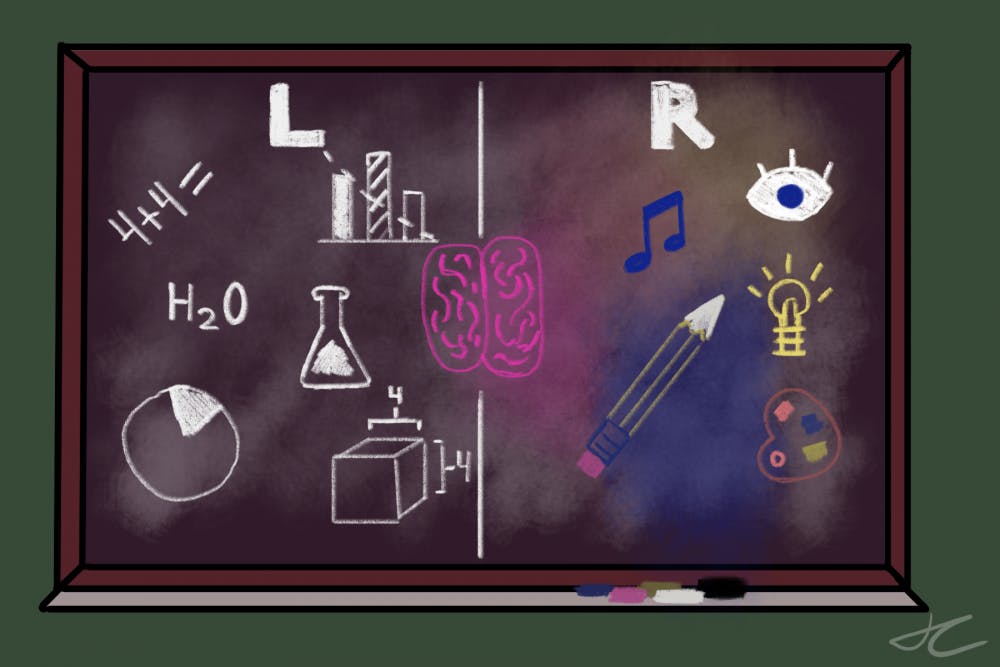Paragraph after paragraph, I would read the text of my required reading material, becoming weary and frustrated that I couldn't understand it.
Listening to lectures, I would miss important information because I have a hard time with auditory retention.
However, once I discovered I was a visual learner, I changed my study habits to be more visual by watching videos or creating pictures to outline complex concepts.
Every student has a different learning style, and it is important for students to embrace their individuality and the unique way they learn. Understanding what type of learner you are is important because this information can be used to your advantage in class and while studying.
There are more than 70 learning styles schemes, but they can be broken down into smaller sensory categories. The acronym VARK is used to describe these categories of learning styles and stands for visual, aural, verbal (reading/writing) and kinesthetic.
“A learning style is basically a learning preference, that's what it is. It just means you prefer to learn in a certain way,” said Roxanna Montoya-Gonzales, program manager for the Center for the Art and Science of Teaching in the Mary Lou Fulton Teachers College.
Visual learners learn best when information is presented to them visually through pictures, graphs and text. In contrast, physical learners or kinesthetic-tactile learners learn by "doing," whether that be by creating a diagram or performing a hands-on activity.
Additionally, auditory learners retain information best when it is presented to them orally, similar to verbal learners who use words and discussions to guide their learning.
Students can also be social learners or solitary learners depending on if they work best in groups and have good communication skills or are more independent and quiet.
“As a learner you want to know what your learning style is because it helps you study, but you don’t want to get so tied down on this label that it almost inhibits your ability to pick up a new skill,” Montoya-Gonzales said.
Online there a numerous tests that can help students figure out what type of learners they are, and while these are helpful, it all comes down to how the student feels they learn best.
Most people already have some idea of what type of learner they are and what situations they excel in academically, but using study tools designed for each type of learner can help students take this idea to the next step.
"From a teaching perspective, this is straight across the board, it doesn’t matter if you're a K-12 teacher or a university professor — when you're teaching you should be aware of all the different learning styles so that you can incorporate enough information in your lesson to address all the different learning needs," Montoya-Gonzales said.
However, the trend of teaching students through specific learning styles has plummeted because some research has failed to prove that learning style assessments improve retention. However, other research found that 61 percent of students had multimodal learning preferences.
If students do prefer to learn in certain ways, what's wrong with them pursuing study habits that match their preferences?
Nothing is wrong with it, but the U.S. education system promotes conformity instead individuality. This is seen in the differences between the U.S. public education system and Montessori schooling.
In Montessori schools, students are in multi-age classrooms where "all kinds of intelligences and styles of learning are nurtured," according to The International Montessori Index.
A study on 59 students in Montessori schools and 53 students in traditional schools found that 5 year olds in Montessori schools were more prepared in elementary reading and mathematics than those in traditional schools and tested better socially and behaviorally.
The study also found that 12-year-old Montessori students were "significantly more creative and as using significantly more sophisticated sentence structures," even though they scored similarly in others skills that related to reading and math.
When students are able to learn the way they feel benefits them best, they do better and develop greater creativity and social skills.
Because some college professors are experts in their fields and do not come from teaching backgrounds, when they teach they don't necessarily know how to appeal to different learning styles or that it is important to present information in different mediums.
Therefore, students must take their education into their own hands, individualizing their educational experiences according to their learning style. We are all unique and should be given the opportunity to learn in the ways we prefer without being told there is no evidence that supports our choice.
Reach the columnist at afsuthe1@asu.edu or follow @a_sutherland10 on Twitter.
Editor’s note: The opinions presented in this column are the author’s and do not imply any endorsement from The State Press or its editors.
Want to join the conversation? Send an email to opiniondesk.statepress@gmail.com. Keep letters under 500 words and be sure to include your university affiliation. Anonymity will not be granted.
Like The State Press on Facebook and follow @statepress on Twitter.




